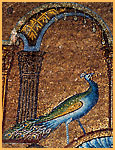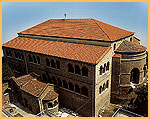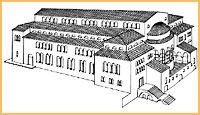|
Thesalonike: The second centre of
the empire
Beginning in the Early Byzantine period, Thessalonika
d evelloped
into one of the major administrative and cultural centers
of the empire. In 536, it was made the administrative capital
of the prefecture of Illyricum by Justinian. The monuments
of the ancient city, namely the hippodrome and adjacent palace
of emperor Gallerius, the baths and the Agora, were maintained
during the Early Byzantine period, but the focus of urban
life shifted towards the ecclesiastical establishments. The
vaulted Rotunda (c. 300) built by Gallerius and possibly intended
as his mausoleum was transformed in the middle of the fifth
century into a church dedicated to the St Asomatoi (and more
recently to St George). The building preserves much of its
splendid fifth- (or possibly sixth-) century mosaic decoration
featuring martyr saints, angels and the Christ in glory. evelloped
into one of the major administrative and cultural centers
of the empire. In 536, it was made the administrative capital
of the prefecture of Illyricum by Justinian. The monuments
of the ancient city, namely the hippodrome and adjacent palace
of emperor Gallerius, the baths and the Agora, were maintained
during the Early Byzantine period, but the focus of urban
life shifted towards the ecclesiastical establishments. The
vaulted Rotunda (c. 300) built by Gallerius and possibly intended
as his mausoleum was transformed in the middle of the fifth
century into a church dedicated to the St Asomatoi (and more
recently to St George). The building preserves much of its
splendid fifth- (or possibly sixth-) century mosaic decoration
featuring martyr saints, angels and the Christ in glory.
Several other churches were erected in the fifth and
sixth centuries, all decorated with luxurious mosaics and
marble brought from the Proconnesian quarries in the Sea of
Marmara. Among them, the  Acheiropoietos
church (450-470), which stands almost intact to this day,
exemplifies the architectural style of the Aegean region.
It is a simple
basilica with
galleries over
the
aisles and
narthex. The
latter opened into the
nave through
a triple arch (tribelon), while the aisles were screened off
by parapet slabs. Within each colonnade, bases, shafts and
capitals are homogeneous. The splendid capitals of the lower
zone with double rows of deeply undercut, lacy acanthus leaves
and the Ionic impost capitals decorated with leaves and tendrils
convey a classical concept of order. Marble sheathing covered
the walls in the aisles, the floors of which were paved in
opus sectile.
Mosaics adorned the half dome of the
apse and the
soffits of both the ground-floor and gallery arcades. Acheiropoietos
church (450-470), which stands almost intact to this day,
exemplifies the architectural style of the Aegean region.
It is a simple
basilica with
galleries over
the
aisles and
narthex. The
latter opened into the
nave through
a triple arch (tribelon), while the aisles were screened off
by parapet slabs. Within each colonnade, bases, shafts and
capitals are homogeneous. The splendid capitals of the lower
zone with double rows of deeply undercut, lacy acanthus leaves
and the Ionic impost capitals decorated with leaves and tendrils
convey a classical concept of order. Marble sheathing covered
the walls in the aisles, the floors of which were paved in
opus sectile.
Mosaics adorned the half dome of the
apse and the
soffits of both the ground-floor and gallery arcades.
A vast, lavishly decorated basilica dedicated to St
Demetrius was erected in the late fifth or early sixth century
on top of a Roman bath, where according to the legend the
saint had suffered martyrdom. The substructure of the bath
was made into a
crypt situated
beneath the altar. In the Early Byzantine period, however,
the focus of devotion was an hexagonal
ciborium situated
on the north side of the nave and decorated with a silver
image of the saint. Local belief placed the body of the saint
under the ciborium: when Justinian asked for the relics of
St Demetrius to be found in the basilica, a surpernatural voice and a fire stopped the men
who had begun digging the church and the emperor was sent
some fragrant dust hastily collected on this spot. At a later
date, the grave of the saint was relegated to the crypt, which
became equipped (probably in the tenth century) with an elaborate
system of pipes exuding miraculous' oil. The church of St
Demetrius is a
transept basilica
entered through the characteristic
tribelon. Nave
and wings are envelopped by aisles (doubled along the nave),
galleries and clerestory windows. A raised pathway (solea)
originally linked the
bema, situated
at the centre of the transept, to the pulpit
(ambo), placed
on the same axis, near the beginning of the nave. The nave
was rebuilt after a major fire which occured c. 620-630. Column
shafts, bases, capitals, and the marble revetment of the arcade
are spoils, hastily thrown together. Fifth-century pieces,
namely acanthus capitals, double-zone capitals with animal
busts, capitals with wind-blown leaves, Ionic impost capitals,
were combined with sixth-century fold capitals, identical
to those at Sts Sergius and Bacchus at Constantinople. The
church suffered again from fire in 1917, when much of the
original sixth- and seventh-century mosaics were destroyed.
These consisted of a series of votive panels with donors asking
for the divine intercession of Demetrius, who was the chief
guardian saint of Thessalonika, or thanking him for a miraculous
healing. On one occasion, St Demetrius introduces a favoured
individual to the enthroned Virgin, who is guarded by two
angels, and to an orant saint, possibly St Theodore; the panel
is attributed to the sixth century.
basilica, a surpernatural voice and a fire stopped the men
who had begun digging the church and the emperor was sent
some fragrant dust hastily collected on this spot. At a later
date, the grave of the saint was relegated to the crypt, which
became equipped (probably in the tenth century) with an elaborate
system of pipes exuding miraculous' oil. The church of St
Demetrius is a
transept basilica
entered through the characteristic
tribelon. Nave
and wings are envelopped by aisles (doubled along the nave),
galleries and clerestory windows. A raised pathway (solea)
originally linked the
bema, situated
at the centre of the transept, to the pulpit
(ambo), placed
on the same axis, near the beginning of the nave. The nave
was rebuilt after a major fire which occured c. 620-630. Column
shafts, bases, capitals, and the marble revetment of the arcade
are spoils, hastily thrown together. Fifth-century pieces,
namely acanthus capitals, double-zone capitals with animal
busts, capitals with wind-blown leaves, Ionic impost capitals,
were combined with sixth-century fold capitals, identical
to those at Sts Sergius and Bacchus at Constantinople. The
church suffered again from fire in 1917, when much of the
original sixth- and seventh-century mosaics were destroyed.
These consisted of a series of votive panels with donors asking
for the divine intercession of Demetrius, who was the chief
guardian saint of Thessalonika, or thanking him for a miraculous
healing. On one occasion, St Demetrius introduces a favoured
individual to the enthroned Virgin, who is guarded by two
angels, and to an orant saint, possibly St Theodore; the panel
is attributed to the sixth century.
|